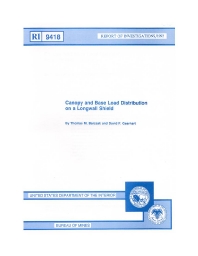 |
This U.S. Bureau of Mines report examines the roof and floor contact pressure provided by the interaction of a shield with the surrounding strata. Controlled forces were applied to an 800-ton two-leg shield in the Bureau's mine roof simulator; the distribution of forces acting on the canopy and base of the shield were measured with 24 hydraulic pressure cells. Several influential factors that affect the load distribution were investigated: (1) the magnitude of loading (leg pressure); (2) the profile of the canopy, principally the upward-sloping tip; (3) the base-lifting device; (4) horizontal load acting on the shield; and (5) compliancy of the immediate roof and floor. It was concluded that the shield does not develop full canopy or base contact without deformation of the strata. Maximum contact pressures are developed at the rear of the canopy and on the toes of the base. Less than 10 pct of the available shield capacity is developed at the canopy tip despite the design intention to ensure tip contact. Horizontal loading reduced the toe pressure acting on the base by as much as 75 pct. The base-lifting device exaggerated the inherently high toe loading, increasing the contact pressure by more than 200 pct.
| Author(s): | Barczak-TM, Gearhart-DF |
| Reference: | U.S. Department of the Interior, Bureau of Mines, Report of Investigations 9418, 1992:1-28 |
ri9418 (PDF, 4632 KB)